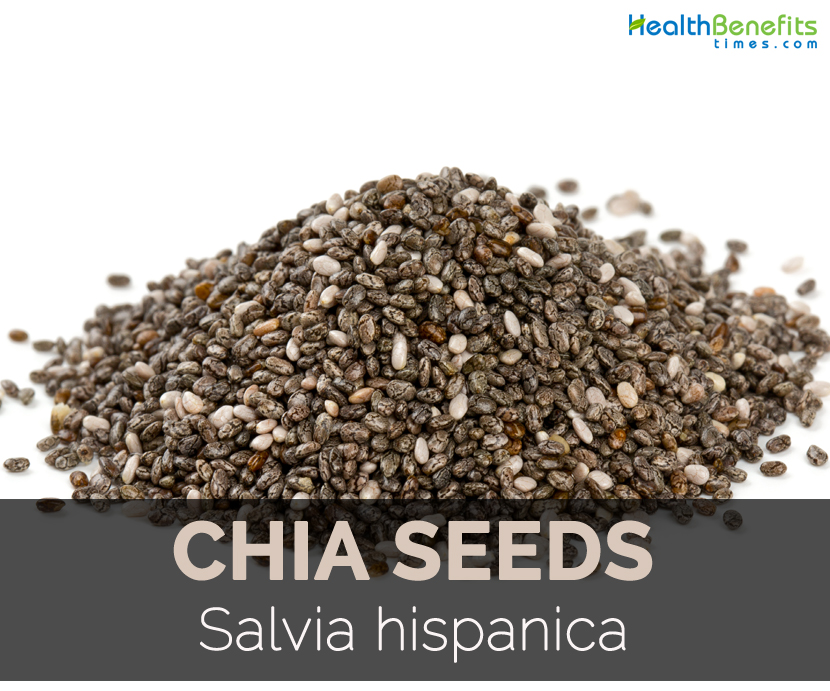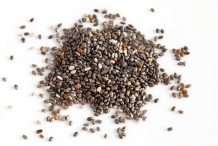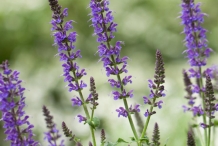It is an erect, low growing or branched herb which grows upto 1.75 meters (5.7 feet) in height. Leaves are green, pointed, ovate, opposite; 4-8 cm (1.6-3.1 inches) long and 3-5 cm (1.2-2 inches) wide. Flowers are hermaphrodite and purple or white in color. Seeds are tiny, oval, smooth and 1 mm in diameter.
History
Chia is native to Central & Southern Mexico and Guatemala. In early 3500 B.C., it was used by Aztecs and became a cash crop of Mexico in between 1500-900 B.C. It was harvested by Toltec and Teotihuacan civilizations in between 2600-2000 B.C in the Mexico Valley. Chia was used by pre Columbian civilizations as raw material to produce medicines. Aztecs use chia as a food or is mixed with other foods, water, ground into flour, beverage and pressed to make oil. In Mexico, Chia survived for 500 years in regional areas. Australia is regarded as the high producer of Chia in the world. Today, chia is cultivated by The Chia company in Australia.
In 16th century, it was cultivated in pre Columbian times by the Aztec. The economic historians consider it as a vital a food crop. In 21 Aztec provincial states, it was provided as annual tribute to the rulers. The chia seed (whole or ground) is used in Bolivia, Mexico, Paraguay, Argentina and Guatemala for food and nutritious drinks.
Nutritional value
28.35 grams of dried seeds covers 138 calories, 244 mg of phosphorus, 0.772 of manganese, 0.262 mg of copper, 15.6 µg of selenium, 0.124 g of tryptophan, 2.19 mg of iron, 9.8 g of dietary fiber, 8.71 g of total fat, 95 mg of manganese, 179 mg of calcium, 2.503 mg of niacin, 0.176 mg of thiamin, 0.227 g of isoleucine, 0.269 g of valine, 0.151 g of histidine, 1.3 mg of zinc, 0.201 g threonine, 0.389 g of leucine, 4.69 g of protein, 11.94 g of carbohydrate and 0.275 g of lysine.
Health Benefits of Chia seeds
Chia seeds are consumed by adding it to protein shakes, cereal, smoothies, yogurt and salads. It is slightly nutty and mild flavor. It is mixed with water which forms likes a clear gel. Moreover, in nutrition it has high content of amino acids and protein. In addition, the chia seeds are used to make breads and are rich in omega-3, protein, fiber, omega-6 and folic acid. It promotes the skin health, heart health, lowers signs of aging, digestive system and builds strong bones. The studies have also shown that it has the ability to heal diabetes.
- Heart health
Chia seeds are rich in omega-3 fatty acids which help to maintain the heart health as well as cognitive health. The research conducted on mice shows that the supplements of omega-3 polyunsaturated fatty acid help to have better, localizatory and spatial memory. (1)
- Form bones
Phosphorus has a vital role in maintaining the teeth and bone health. It assists calcium for forming strong bones. It enhances the gum health and the enamel of tooth. It alleviate the ailments such a loss of mineral density and bone loss which is also called osteoporosis. It promotes the overall health and the functions. The adequate intake of phosphorus is associated with healthy heart and cardiovascular diseases. (2)
- Level of sugar
Manganese helps to control the level of blood sugar in the blood of humans. It also prevents the chances of diabetes. It controls the sugar level in the blood, normalize secretion and synthesis of insulin as well as the uncertain drops of sugar. (3)
- Treat arthritis
Copper is associated with anti-inflammatory properties that helps to reduce the arthritis symptoms. The arthritis patients use the copper bracelets with a belief that it will help in curing this ailments. Copper is stored in the water overnight and should consume in the morning after waking up. It raise the metabolism for the proper functions. (4)
- Form hemoglobin
Iron provides the shade of dark red to the blood and assists to transport oxygen to the body cells. The body requires extra hemoglobin because the blood is lost due to internal and external injuries. Mostly women lose blood during menstruation due to which they are at high chances of suffering from anemia. (5) (6)
- Treat cramps
Magnesium treats the kidney stress, back muscles and muscular tension. It assists in the calcium absorption that assists the bone healing faster. Its deficiency leads to the symptoms of leg cramps and general fatigue. The adequate intake of magnesium helps to treat the chronic leg cramps. (7)
- Skin health
The studies show that zinc aids acne and pimples. Zinc helps to promote the function of white blood cells which assist the healing process and prevent the body from infections such as ulcers, canker sores, surgical incisions, burns and wounds. It is essential for collagen production that is essential for the regrowth and repair of skin. (8)
- Cure eczema
Eczema is a chronic skin disorder which is caused due to the zinc deficiency in body. Zinc is vital for the treating the infections and supports the restoring ability for healing properly. The balance of zinc in the blood helps to alleviate the irritation. (9)
- Prostate health
Zinc helps to maintain the prostate health. The deficiency of zinc enlarges the prostate gland and sensitive to cancer. The prostate disorder patients should take 15 mg of Zinc daily under the medical observation. The studies show that the adequate presence of zinc in the blood helps to lower the growth of tumor. (10)
- Pregnant women
Zinc is vital for repairing of DNA and its functions. It is vital for the cell growth and builds the cell constituents during pregnancy. During pregnancy various enzymatic and development activity so zinc is essential for the mothers and infants. (11)
Precautions
- Blood Thinning
It contains high content of Omega-3 fatty acids due to which it acts as a blood thinner. Those who take the blood thinners or are scheduled for surgery should not consume Chia seeds. The excessive use of blood thinners result in excessive bleeding which might be harmful to the health.
- Drop in Blood Pressure
The high blood pressure patients should consult doctor before using chia seeds. It possess the properties which helps to lower the diastolic blood pressure.
- Allergic Reactions
Chia seeds might cause an allergic reaction such as rashes, watery eyes and hives. It also results in severe symptoms such as problem in breathing, vomiting, tongue swelling and diarrhea.
Tips for serving Chia Seeds
Chia seeds possess mild nutty taste and usually used for garnishing dishes. Some tips are provided below:
1. Chia pudding
Chia seeds and coconut milk are great for making pudding for breakfast. Combine ingredients a night before and put it in fridge. The next day it becomes a special treat.
2. Debloating beverage
Chia seeds should be mixed with water and consume it by chasing it with water.
3. Blueberry chia muffins
Blueberry muffins is the chia filled recipe which is baked into batter.
4. Antioxidant berry smoothie
It could be tossed into the morning smoothie. It contains high content of Vitamin C and fiber.
5. Cherry Chia Seed Pudding
Blend almond milk, cardamom, cherries, vanilla and stevia into a creamy mixture. The chia seeds should be soaked till it becomes thick. The cashew cream is used as a topping for Chia pudding.
6. Chocolate Pistachio Chia Shake
Mix chia seed, almond milk with medjool dates, cocoa powder, roasted pistachios, Greek yogurt, frozen banana and vanilla extract. Extra almond milk could be added.
7. Banana Chia Seed Cake
Use tapioca flour, almond flour and flaxseed meal as a base for cake. Eggs and banana helps to bind everything whereas coconut milk, vanilla extract, coconut oil and honey provides a sweet flavor. It could be topped with butter or add cream cheese for frosting.
8. Serrano Pineapple Papaya Smoothie with Chia
Fresh ginger and Serrano chile provides spicy kick to this smoothie. The mixture of pineapple juice and chia seeds helps to thicken mixture. It could be put in freezer for about 10 minutes before serving .
9. Healthy Gluten-Free Chia Chicken Tenders
Ground flaxseed, chia seeds, herbs and Parmesan cheese helps to bread the gluten free chicken. Then, it should be baked.
10. Gluten-Free Macaroons with Raspberry Chia Seed Jam
Mix shredded coconut, maple syrup, coconut cream and corn starch. The mixture should be topped with the jam of Raspberry chia seed and then bake it.
11. Chia Breakfast Pudding
Chia seeds should be soaked in the vanilla almond milk the whole night. Then combine it and use the fresh nuts and fruits as toppings. Keep it in fridge for about five days.
12. Sticky Chia Brown Rice with Fried Egg
Add chia seeds to the fried egg dish and simple sticky rice.
13. Chia Fresca Drink
This tropical beverage is loaded with omega-3 fatty acids as well as potassium. Just use coconut water, chia seeds and pineapple juice to keep it simple. But a drizzle of maple syrup could be added for sweet.
14. Chocolate and Coconut Chia Seed Mousse
Grind Chia seeds for a smoother and mousse texture. Mix ground chia seeds, coconut butter, coconut milk, sweeteners and cacao powder. Then leve it for twenty four hours to get thicken.
Traditional uses
- The Chia seeds oil has high amount of Omega-3, 9 and 6 fatty acids.
- The seeds are used as a thirst quencher or survival food.
- It helps to reduce LDL cholesterol, triglycerides and raise HDL cholesterol.
- It also possesses anti-cancer properties.
- Seed are considered as digestive, febrifuge, disinfectant and ophthalmic.
- The infusion made from Chia seeds helps to treat fevers.
- A seed poultice is applied to infections.
- The chewing of seeds provides strength in long journeys.
- Seeds help to clean eyes and eliminate foreign particles from eyes.
Precautions
- The allergic reactions such as rash, facial swelling, watery eyes, hives, rashes, dizziness and shortness of breath might be experienced.
- One should be conscious of the side effects before consuming it.
- The people allergic to Chia seeds should stay away from Chia seeds.
- The excessive use of Chia seeds provokes side effects.
How to Eat
- The seeds are soaked in water and are flavored with cooling drink and fruit juices.
- The seeds (gelled) are used to make pudding or gruel.
- The seeds are sprouted consumed by adding it in salads, soups, sandwiches, stews etc.
- The grounded seeds are added to meals, biscuits, bread, cakes etc.
- Chia seeds are also consumed raw or added to dishes.
- Grounded chia seeds are used in pinole.
- The gelled seeds are used in pudding or porridge.
- The leaves are used as teas or nutritious drink.
- Chia seeds are sprinkled over yogurt, smoothies, cereal and oatmeal.
- It is added to juices, drinks, milk shakes and protein shakes.
- It is added to omelets and salads.
Other Facts
- Chia plant is considered as the member of mint family which is originated from Central Valley of Mexico and is a member of the mint family.
- Before 3500 B.C, Chia seeds were used as a source of food.
- Chia fresca is a Mexican drink which is made by soaking Chia seeds in water till gelatinous and adds sugar as well as lime or lemon juice.
- It helps to hydrate body.
- Chia seeds are rich in antioxidants and could be stored for long time periods as it does not get spoil quickly.
References:
http://healthresearchfunding.org/chia-seeds-side-effects/
http://www.herbs2000.com/herbs/herbs_chia.htm
http://www.herbgarden.co.za/mountainherb/herbinfo.php?id=294
http://tropical.theferns.info/viewtropical.php?id=Salvia+hispanica
http://herbgarden.co.za/mountainherb/article.php?tag=MexicanChia
http://www.herbwisdom.com/herb-chia-seeds.html
http://www.medicalnewstoday.com/articles/291334.php
https://www.organicfacts.net/health-benefits/seed-and-nut/health-benefits-of-chia-seeds.html
Comments
comments
| Chia seeds Quick Facts | |
|---|---|
| Name: | Chia seeds |
| Scientific Name: | Salvia hispanica |
| Origin | Native to Central & Southern Mexico and Guatemala |
| Colors | Black, brown, white (Seed) |
| Shapes | Tiny, oval; Diameter: 1 mm (Seed) |
| Calories | 138 Kcal./cup |
| Major nutrients | Phosphorus (34.86%) Manganese (33.57%) Copper (29.11%) Selenium (28.36%) Tryptophan (28.18%) |
| Health benefits | Heart health, Form bones, Level of sugar, Treat arthritis, Form hemoglobin |
| More facts about Chia seeds | |



